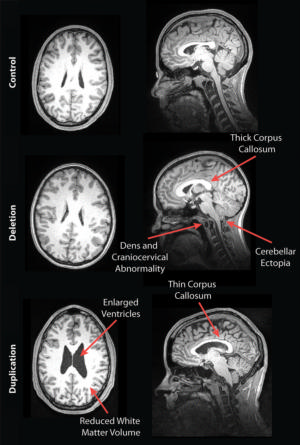MRI Reveals Striking Brain Differences in People with Genetic Autism
Researchers have identified structural abnormalities in the brains of people with one of the most common genetic causes of autism

In the first major study of its kind, researchers using MRI have identified structural abnormalities in the brains of people with one of the most common genetic causes of autism, according to a new study in Radiology.
Autism spectrum disorders affect more than 3.5 million people in the U.S., according to the Centers for Disease Control and Prevention. Many people with autism have abnormalities at a specific site on the 16th chromosome known as 16p11.2. Deletion or duplication of a small piece of chromosome at this site is one of the most common genetic causes of autism spectrum disorder.
“People with deletions tend to have brain overgrowth, developmental delays and a higher risk of obesity,” said study author Julia P. Owen, PhD, a brain researcher at the University of Washington in Seattle, who was at the University of California in San Francisco (UCSF) during the study. “Those with duplications are born with smaller brains and tend to have lower body weight and developmental delays.”
The researchers at UCSF and four other sites performed structural MRI exams on 79 deletion carriers, ranging in age from 1 to 48, and 79 duplication carriers, ages 1 to 63, along with 64 unaffected family members and 109 participants in a control group. Researchers used unsupervised machine learning to cluster radiologic features. An association between clusters and cognitive and behavioral scores from IQ testing and parental measures of development were tested by using analysis of covariance. Volumetric analysis with automated segmentation was used to confirm radiologic interpretation.
The participants completed a battery of cognitive and behavioral tests, and neuroradiologists reviewed the brain images for development-related abnormalities. The results showed some striking differences in the brain structures of deletion and duplication carriers compared with non-carriers. For instance, the corpus callosum was abnormally shaped and thicker in the deletion carriers but thinner in the duplication carriers, compared to the control group and familial non-carriers.
Other stark differences were apparent. The deletion carriers displayed features of brain overgrowth, including the extension of the cerebellum toward the spinal cord. The duplication carriers showed characteristics of brain undergrowth, such as decreased white matter volume and larger ventricles.
When the researchers compared cognitive assessments to imaging findings, they found that the presence of any imaging feature associated with the deletion carriers — such as a thicker corpus callosum — indicated worse daily living, communication and social skills, compared to deletion carriers without any radiological abnormalities. For the duplication carriers, the presence of decreased white matter and corpus callosal volume and increased ventricle size was associated with decreased full-scale and verbal IQ scores, compared to duplication carriers without those findings.
The identification of the radiologic features associated with cognitive and behavioral deficits may inform neurologists who see 16p11.2 CNV carriers in a clinical setting, according to researchers.

Web Extras
- Access the study, “Brain MR Imaging Findings and Associated Outcomes in Carriers of the Reciprocal Copy Number Variation at 16p11.2.” at http://pubs.rsna.org/doi/pdf/10.1148/radiol.2017161732